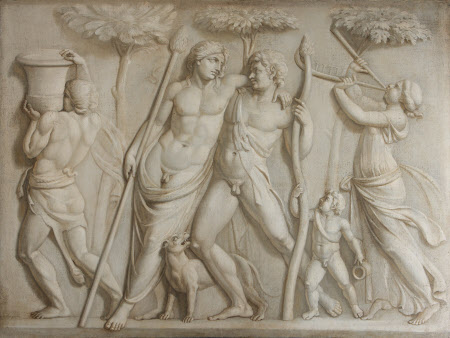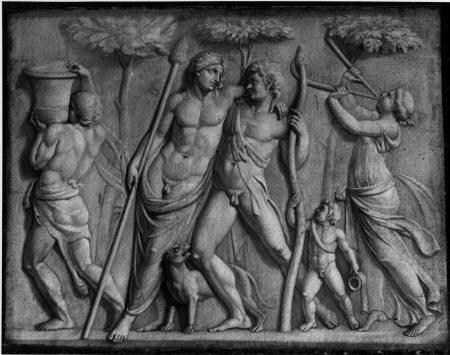Bacchus (Dionysus), Ampelos, Silenus and a Maenad
Robert Fagan (1761 - Rome 1816)
Category
Art / Oil paintings
Date
1793 - 1795
Materials
Oil on canvas
Measurements
1092 x 1473 mm (43 x 58 in)
Place of origin
Italy
Order this imageCollection
Attingham Park, Shropshire
NT 609084
Caption
Robert Fagan was a somewhat bohemian figure of Irish parentage who lived in Rome from 1784 to 1807, painting portraits, excavating and selling classical sculpture, and dealing in Old Masters. In a fit of melancholia in 1816 he committed suicide by throwing himself out of a window. All four grisailles (monochrome paintings) by him at Attingham were presumably commissioned by Thomas Noel Hill, 2nd Lord Berwick (1770-1832), on his visit to Italy in July 1792. This was copied after a Roman marble relief, now in the Museo Nazionale, Naples. Ampelos was a beautiful youth with whom Bacchus fell in love. He gave Ampelos a vine laden with grapes as a token of his love. The vine hung from the branches of an elm tree, and Ampelos climbed the tree to pick the fruit and fell to his death. Bacchus named the vine ampelos after him that he might be remembered forever.
Summary
An oil painting on canvas of the Roman God Bacchus (called Dionysus by the Greeks), Ampelos, Silenus and a Maenad. The painting is by Robert Fagan (Cork c.1745 – Rome 1816) and was done around 1793 to 1795. It is a grisaille overdoor for the Entrance Hall at Attingham Park and was comissioned by Thomas 2nd Lord Berwick (1770-1832). The painting is after the original Roman marble relief of a Dionysus procession, 50 AD. in the Museo Nazionale, Naples. Fagan's version omits with a figure of a Maenad with cymbals and a small boy. The painting includes five full-length figures. On the left a muscular male is striding forward to the left with his left leg forward and his back turned to the spectator. He is carrying a large open-topped vessel on his left shoulder, supported at the bottom by his left hand and on the top by his right. He wears an animal skin loincloth loosely tied at the waist, a small drape billowing from his right shoulder and wrapping itself around the trunk of a tree. Behind him stands a naked Bacchus with a diaphanous drape across his thighs and knees is striding forward to left, his left leg forward. His body faces the viewer but he is leaning to the right, his head turned, almost in profile to the right. In his right hand he holds a Thyrsus (a wand tipped with a pine cone – an ancient fertility symbol). His left arm is around the shoulders of the naked figure of Ampelus, who strides forward with his right leg. His body faces the viewer but his head is in profile to the left. He is wearing a small diaphanous drape hanging from his right shoulder. He holds a Thyrsus in his left hand. Between the feet of Bacchus and Ampelos is a dog, turned to the left, head turned upwards to right. Behind Ampelos, to the right, is a naked child also holding the Thyrsus in his right hand and a jug in his left. Behind him to the far right is a maenad playing an aulos, striding forward with her right foot, wearing classical robes.
Provenance
Presumably commissioned by Thomas Noel Hill, 2nd Lord Berwick (1770-1832) on his visit to Naples in 1792/3; bequeathed to the National Trust in 1947 with the estate, house and contents of Attingham by Thomas Henry Noel-Hill, 8th Baron Berwick (1877-1947) on 15th May 1953.
Credit line
Attingham Park, The Berwick Collection (National Trust)
Makers and roles
Robert Fagan (1761 - Rome 1816), artist

